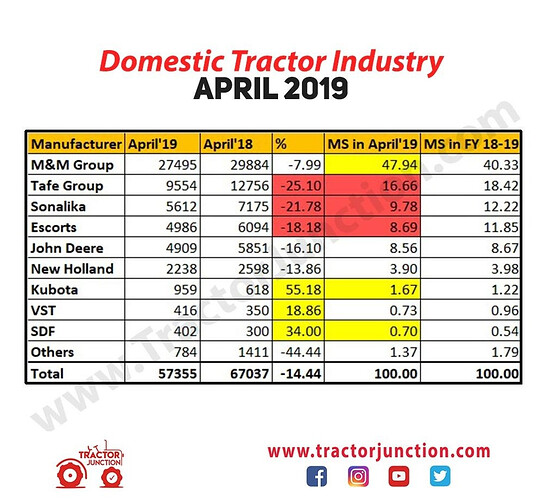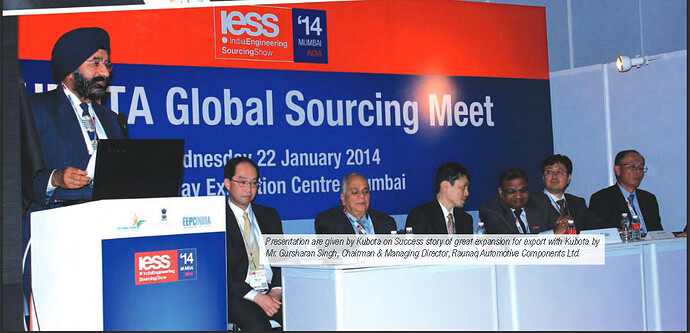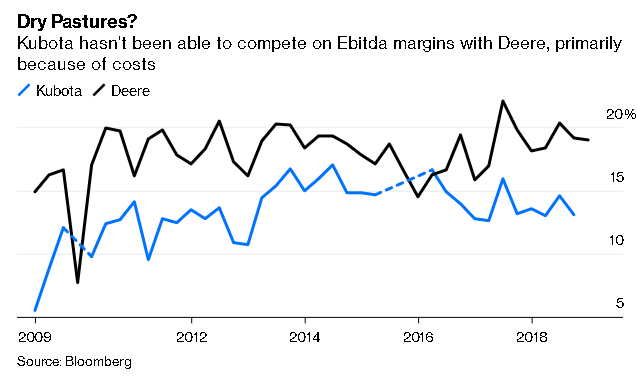Thanks @Shikhar for the excellent OP. The export sales cagr and the increasing RoCE piqued my curiosity.
However, the below point from Ankit’s summary was very insightful.
Dumping the information gathered while researching about Kubota.
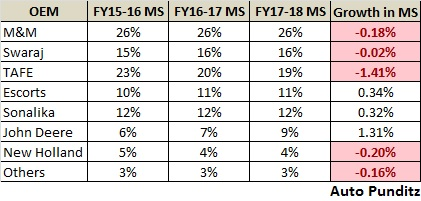
While M&M+Swaraj have gained significant YoY growth; it has lost in terms of Market Share. The biggest gainer in FY17-18 was John Deere! It has silently jumped from a Market Share of 6% in FY15-16 to 9% in FY17-18. Other gainers were Escorts & Sonalika who registered a Market Share of 11% & 12% respectively.
http://www.autopunditz.com/autopedia/tractor-sales-statistics-india/
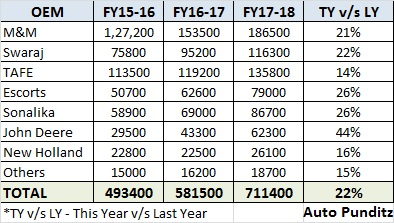
Kubota Agricultural Machinery India Pvt. Ltd. (KAI), the Indian subsidiary of Kubota Corporation, Japan, has achieved a phenomenal 35 per cent growth rate in India.
As per recent Tractor and Mechanization Association (TMA) data, Kubota has sold a total of 10877 units in the year 2018-19 viz-a-viz 8036 units in 2017-a growth rate of 35 per cent and making it fastest growing tractor company in India in the Tractor Industry across all companies.
“India is a strategic market for us foreseeing continuous growth in the tractor industry. Achieving this growth rate has re-assured us that we are heading in the right direction. Kubota has earned its position of leadership in global markets due to our superior products and reliability of quality along with service, which is scaling our growth,” said, Akira Kato, Managing Director, Kubota Agricultural Machinery India Pvt. Ltd.
https://www.business-standard.com/article/news-ani/kubota-becomes-the-fastest-growing-tractor-company-in-india-119041600532_1.html
In addition, report findings suggest that despite slowest growth, small tractor players’ hiked their market share in the last fiscal, squeezing the market share of the big ones.
Mahindra & Mahindra (M&M), the largest tractor maker in India experienced 1 per cent decline in market share to 40.2 per cent. Similarly, TAFE’s share contracted marginally by 0.2 per cent to 18.4 per cent.
“M&M and TAFE have lost 140 bps and 20 bps market share, respectively in FY2019 while Escorts and Sonalika have gained 110 bps and 40 bps share, respectively over this period. Smaller overseas players such as Kubota (+35 per cent yoy) and New Holland (+20 per cent yoy) have grown at a faster pace and have gained some market share. Mahindra has lost market share across all major markets except Bihar,” report added.
Market share in FY’18 (%) OEMs Market share in FY’19 (%) 41.6 M&M (with PTL) 40.2 18.6 TAFE (with Eicher Motors) 18.4 10.7 Escorts Ltd 11.8 11.8 Sonalika 12.2 17.3 Others (John Deere, New Holland etc) 17.5 100 Total 100 Source: Kotak Institutional Equities
India Tractor Industry: Tractor sales growth pace hits three-year low in FY’19, ET Auto
2016 Annual Newsletter of Kubota was dedicated to their Indian division.
The above report highlights the extensive market research that went into gathering the insights for making the design of MU5501 multi-purpose tractor which is a worthwhile read.
But more importantly it corroborates the points highlighted by Ankit’s AGM Notes.
Raunaq Automotive Components Ltd. has been supplying parts to the Kubota Group since the opening of its Delhi Office in 2006. With guidance from Kubota’s Procurement HQ, the company’s quality and production control improved dramatically. The company now supplies gear parts to Kubota Group factories in Japan and Thailand. It also became the first company to deliver mass-produced Indian-made gears to Japan. Raunaq Automotive Components Ltd. President Gursharan Singh looks back on those days.“I was surprised because Kubota’s approach to manufacturing from the material level and ensuring quality control was new to India. Kubota guided us to the achievement of quality levels that are standard in Japan. I feel that Kubota has raised us up.” The fact that Raunaq Automotive Components was supplying parts to a global brand quickly became known to other manufacturers. Backed by the credibility of dealing with Kubota, Raunaq Automotive Components started dealing with major European and American car manufacturers, and the company is growing rapidly. Today, roughly 50% of its sales is generated through export. Mr. Singh is expecting Kubota to establish a local production system in India as soon as possible. The supply chain for parts sourcing is already almost completed, and preparations for local production are progressing.
Kubota Global Sourcing Meet
https://www.eepcindia.org/download/150323164211.pdf
Segmental Revenue Mix
| FY13 | FY14 | FY15 | FY16 | FY17 | FY18 | FY19 | |
|---|---|---|---|---|---|---|---|
| 2W | 34% | 48% | 38% | 35% | 45% | 45% | 45% |
| Tractors | 16% | 20% | 24% | 29% | 26% | 21% | 19% |
| 3W | 21% | 19% | 23% | 21% | 15% | 13% | 14% |
| CV | 7% | 8% | 5% | 9% | 9% | 6% | 5% |
| Industrial | 4% | 3% | 6% | 3% | 5% | 5% | 4% |
| Recreational | |||||||
| (ATV) | 12% | 1% | 10% | 13% | |||
| Others | 6% | 1% | 4% | 3% |
Kubota is facing stiff competition with John Deere in US and declining demand in China which makes India and Africa more important for its growth.
Kubota’s Ebitda margins have trailed Deere’s by 5 percentage points to 10 percentage points. Costs between the two largest competitors have diverged, with the Japanese equipment maker’s climbing to 73 percent of net sales, although both have been affected by tariff pressures on raw materials. Kubota has been behind in raising prices. While profit growth is chugging along, its return on equity is about 11 percent, compared with more than 20 percent for Deere.
A move into greener pastures such as India or Thailand could help. Kubota recently set up a joint venture in India, one of the world’s largest markets for farm tractors. Still, that won’t be enough to compensate for a drop in Chinese demand, which is already affecting the company’s Asian sales. Besides, Deere also has a large presence in India.
Kubota’s strategy has been as slow-moving as its signature vehicles. This tractor maker needs to find a higher gear if it’s going to close the gap.
https://www.bloomberg.com/opinion/articles/2019-01-21/deere-bests-kubota-as-u-s-tractor-sales-reviveKubota first started exporting tractors to India in 2008, focusing on the southern end of the subcontinent, since the rice crops there aligned with the Japan-honed technology. In 2015, Kubota developed other models designed for hauling crops and other purposes outside of cultivation, in a bid to answer demand.
Kubota’s tractors have drawn buyers thanks to their fuel efficiency and low noise. During the first nine months of 2018, the company sold 6,700 units, a roughly 50% jump from a year earlier. But Kubota’s Indian market share still wallows at around 1%.“We’ve been active there for a decade, but we have yet to reach cost competitiveness,” said President Masatoshi Kimata. Among tractors in the 50-horsepower range – the mainstream option in India – machines that Kubota imports from Thailand fetch a market price of about 800,000 rupees ($11,000) in the Mumbai area. That’s around 10% more expensive than similar offerings from Mahindra.
To better compete against Indian rivals, Kubota has formed a joint venture with Escorts, the country’s fourth-largest tractor seller. The partners will build a plant in the northern Indian state of Haryana, due to start mass production next June, with a goal of producing 50,000 units in 2022.
Kubota will reduce production costs 20% by utilizing Escorts’ component supply chain, and its sales network will double to 400 dealers by 2023, stretching to every corner of India. The company positions India as a key global growth market, with sales expected to soar 130% to 30 billion yen ($275 million) in 2022
Deere & Co., the U.S. maker of John Deere tractors, has carved out a 10% market share in India, earning it fifth place. After years of competing against both Kubota and Mahindra on its home turf, Deere decided to take the fight to India in 2000, where it formed a joint production venture with a local concern, later converting the venture into a fully-owned subsidiary in 2005. When it comes to branching out to India and launching local production there, Deere enjoys a substantial head start against Kubota.
Now, Deere plans to boost engine production to match its Indian tractor-manufacturing capacity, which amounts to over 130,000 units a year including export-bound goods, according to local new sources. That way, the company will not have to rely on imports. Deere also introduced a 28-horsepower small tractor into the market last month.
Other Japanese players have recently joined the fray. In a deal completed in 2017, Yanmar Holdings lifted to 30% its stake in International Tractors, India’s third-ranked tractor company, and the two are jointly developing new tractors. Iseki formed a collaboration last November with Tractors and Farm Equipment, India’s second-largest seller, to sell high-perfomance midsize tractors.
Global tractor makers seek fertile ground in Indian market - Nikkei Asia
Disc: Invested around 15% of pf over the last 2 months. Not a recommendation. Please do your own due diligence.

